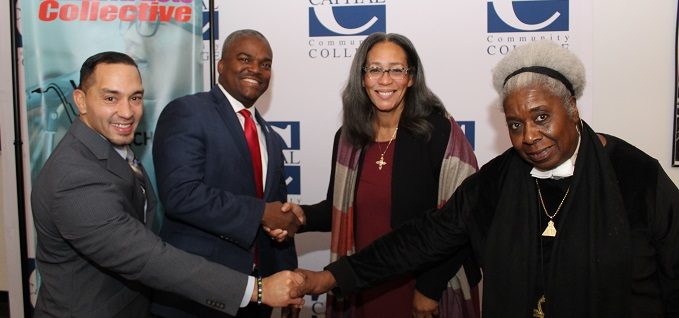Leaders focus on diversity
By Ed Finkel
February 18, 2020
Former participants in the American Association of Community Colleges’ Future Presidents Institute say leaders must maintain a focus on the strengths and challenges that their diverse campuses face.
Located in the fifth-poorest city in Connecticut with sizable gaps in wealth and educational achievement, Capital Community College in Hartford sees itself as a social justice and equity institution, says Duncan Harris, interim CEO, who has served on the AACC Commission for Diversity, Inclusion and Equity. For example, the college hosted a recent dialogue about reentry from the criminal justice system and how to reduce recidivism.
Capital also has received a grant from the Hartford Foundation to create an Equity, Diversity and Inclusion Center, and Harris has granted release time to a faculty member to serve as director. The center will provide students with support to overcome non cognitive barriers that prevent them from succeeding, such as not having enough money for the electric bill, Harris says.
“Being in Hartford, on a daily basis observing the impact of how inequity and inequitable practices manifest themselves in the citizenry, this is our clarion call,” he says.
The Miami Dade College – Medical Campus is majority minority and culturally diverse, with significant Haitian and Venezuelan populations as well as from other countries in the Caribbean, says Bryan Stewart, campus president. “They all come with different levels of experience. We have to support them so they succeed,” he says. “This group of students may have issues with language; we have a writing coach on campus.”
Stewart and other administrators are always aware that a student’s success not only changes their own life but can alter the entire history of their family. “We serve a variety of students here in Miami who are a melting pot,” he says. “Our faculty are very aware of it in the classroom. They know the diversity and the different backgrounds. Students are aware of it, but they are used to it and blind to it—in a positive way. They’re focused on their goals.”
As part of the leadership of a Hispanic-serving institution focused on the needs of the Latinx population, Chio Flores, vice president of student services and enrollment management at Wenatchee Valley College, says she’s worked to advance equity and inclusion. “Understanding the work we do through equity and inclusion is very critical,” she says.
For example, “I have guided work with regard to increasing our support services through the writing of grants that help advance students or staff.”
Diversity and equity are the lifeblood of community colleges, believes Deanna Yameen, provost at Massasoit Community College.
“We’ll never do well enough with [diversity],” she says. “Equity is really hard, but we can’t settle for anything less. … We want inclusive excellence on campus. That work is going to be ongoing. As long as it’s joyful work, those are hard conversations you have to have.”
Community colleges need to root out the way inequities are built into systems and policies, as well as the nation as a whole, Yameen says.
“That’s the reason you go to work every day,” she says. “If you just do a couple of workshops, your campus is obviously not committed. … Those dialogues are really hard, but we have to have them. Otherwise our campus won’t work for everybody; it won’t be welcoming, and it won’t be fair.”
This is an excerpt from the forthcoming issue of Community College Journal, which is going to print soon.
The next AACC Future Presidents Institute will take place June 1-3 in Washington, D.C. More details are available here.



